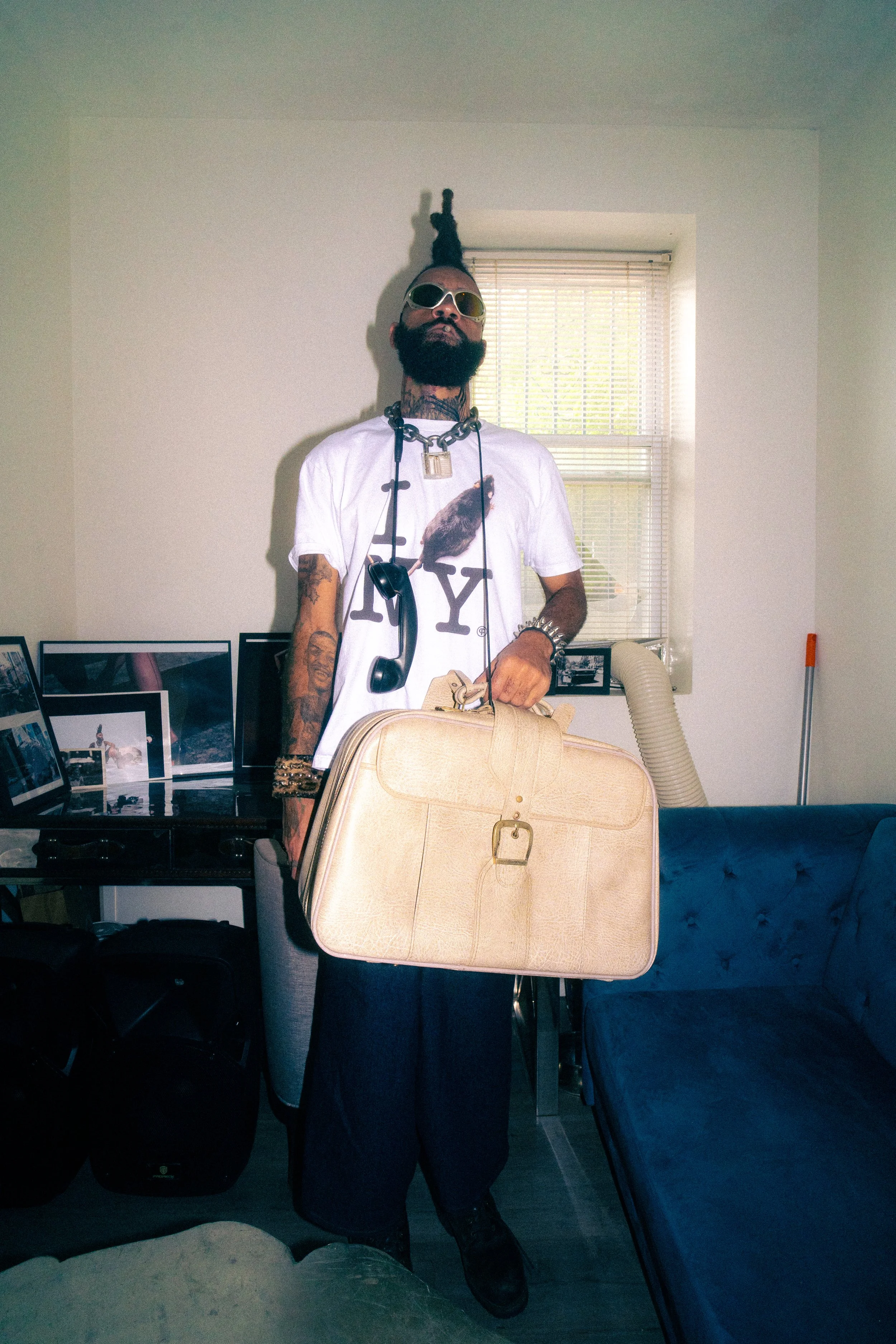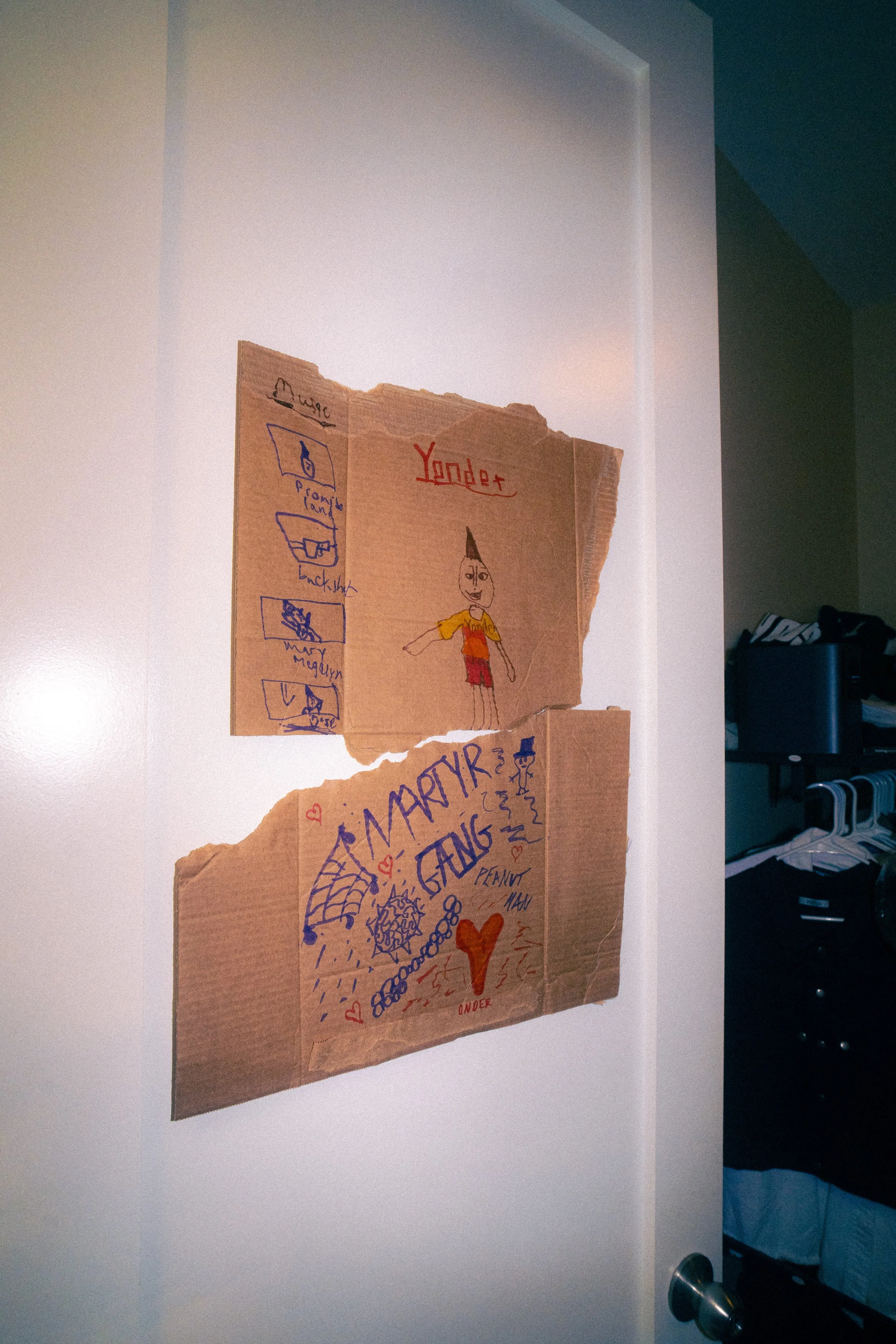YONDER: The Black Punk Renaissance
YONDER covered in his collection of vintage Playboy magazines.
Between rage and therapy, of chaos and love, one artist is curating a new auditory experience through the punk underground — and he’s not asking for permission. He’s claiming it.
He goes by YONDER, but if you ask the pits, the streets, or the growing legion of fans behind him, he’s The Black Punk. And this isn’t just a title. It’s a war cry.
“The name was given to me by other artists,” Yonder explains, read back with pride and inevitability. “And I just happened to claim it because I thought it was fitting. I want there to be a Black Punk revival — not a remake of old punk — but something new, genreless, intentional, and painful. Something honest.”
This vision doesn’t wear safety pins for nostalgia or thrash for empty shock value. Yonder’s version of punk rips out the performative theatrics and replaces them with something heavier, more urgent — an embodied protest against creative limitation and cultural erasure. It’s less about breaking rules for spectacle, and more about burning the rulebook so something freer can rise from the ashes.
Before the Black Punk Renaissance could begin, there had to be stillness.
“I took two years off to figure out who I really was,” Yonder says, recalling a period of intentional withdrawal from the scene. “I was tired of people trying to box me in — ‘you’re this kind of artist, you sound like this person.’ I had to go back to my roots. Strip everything down until I was raw again.”
Those two years weren’t glamorous. No festivals. No frantic release schedule. Just writing, experimenting, breaking apart sounds until he could build something truer. “It was humbling,” he admits. “I had to be okay with disappearing for a while to come back sharper.”
When Yonder returned, his performances became something more than concerts — they became communal rituals.
“You might see a mosh pit and think it’s aggressive,” he says, “but there’s so much love in it. It’s therapy. At my last show, there were kids in the pit, and everyone formed a protective circle around them. That would never happen at a rap show. It’s consent-based. It’s sacred.”
In Yonder’s world, the pit isn’t chaos for chaos’ sake. It’s a controlled storm — an exchange of energy where rage becomes release, fear becomes power, and strangers move as one. That space, he says, is where true punk lives: “It’s not about violence. It’s about being alive together.”
Baltimore shaped him. Brooklyn sharpened him.
Growing up in Baltimore, Yonder absorbed a rawness and resourcefulness that still fuels his art. “Baltimore taught me how to make something out of nothing,” he says. “How to build even when no one’s looking. How to stand on your own two feet.”
Our music column is powered by NEWM, an official sponsor of ARCHIV3.
NEWM is redefining what it means to be an independent artist — with decentralized tools that give you full ownership, creative freedom, and new ways to earn from your music without giving up agency. Join NEWM — the Web3 platform giving power (and profits) back to artists. Discover →
The move to Brooklyn wasn’t just relocation — it was strategy. “Brooklyn is the land of opportunity. You can sell merch at the park, meet someone major at a gallery, or cut records with legends at the studio. You never know who you’re gonna run into.”
It’s a city that rewards boldness, and Yonder thrives in its unpredictability. “Every day here feels like it could change my life,” he says.
Yonder’s network is expanding — and not by accident. One of his current collaborators is Left Brain of Odd Future, whose experimental production is pushing Yonder into rawer, stranger sonic territory. “Working with him is like opening a door to a completely different universe,” Yonder says.
He also cites Trouble Andrew — the artist and designer behind the GucciGhost phenomenon — as a creative north star. “I respect people who make art for a living,” he says. “People who are free in every medium. That’s the goal: freedom.”
For Yonder, art isn’t meant to be safe.
“I hope my art pisses people off. I hope it makes them cry,” he says without hesitation. “I don’t want to sit in the middle. My job as an artist is to make people love me or hate me — not scroll past me.”
This philosophy bleeds into his live shows, where unpredictability is part of the design. He refuses to announce set lists. He rearranges songs mid-performance. He treats the stage like a living organism — one that can morph, erupt, or fall silent without warning.
YONDER emphasizes his relationship with Brooklyn, where community connections are prevalent - where you can run into anyone, anywhere, like artist, @spacejam_x.
When asked about future projects, Yonder keeps his cards close. “You have to find out,” he says with a smirk. “My goal is to be the most unpredictable artist of all time.”
It’s not coyness — it’s conviction. For Yonder, mystery isn’t a marketing tool; it’s the natural state of a movement still in its early chapters. And the Black Punk Renaissance isn’t a short-lived wave. It’s a generational shift.
When it arrives in full, Yonder won’t just be at the center. He is the center. And the pit is waiting.
Yonder will be featured in ARCHIV3 Magazine’s 1-Year Anniversary issue on August 30th.
RSVP here: https://posh.vip/e/archiv3-magazine-celebrates-1-year-art-music-culture-tech
Writing and photography by Josh Sauceda.

















